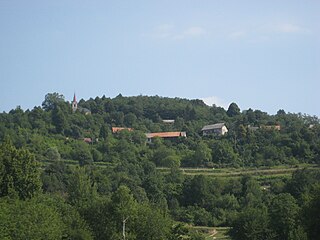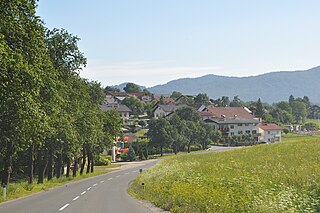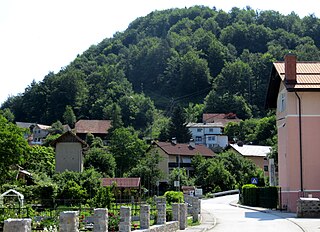
Volčji Potok is a village on a terrace on the left bank of the Kamnik Bistrica River in the Municipality of Kamnik in the Upper Carniola region of Slovenia.

Križevska Vas is a small settlement in the Municipality of Dol pri Ljubljani in the eastern Upper Carniola region of Slovenia.

Bojanja Vas is a village in the Municipality of Metlika in the White Carniola area of southeastern Slovenia, next to the border with Croatia. The entire area is part of the traditional region of Lower Carniola and is now included in the Southeast Slovenia Statistical Region.

Boršt is a small settlement on the left bank of the Kolpa River in the Municipality of Metlika in the White Carniola area of southeastern Slovenia. The entire area is part of the traditional region of Lower Carniola and is now included in the Southeast Slovenia Statistical Region.

Gornji Suhor pri Metliki is a settlement in the Municipality of Metlika in the White Carniola area of southeastern Slovenia, right on the border with Croatia. The entire area is part of the traditional region of Lower Carniola and is now included in the Southeast Slovenia Statistical Region.

Krašnji Vrh is a small village in the Municipality of Metlika in the White Carniola area of southeastern Slovenia, right on the border with Croatia. The area is part of the traditional region of Lower Carniola and is now included in the Southeast Slovenia Statistical Region.

Podzemelj is a village on the left bank of the Kolpa River in the Municipality of Metlika in the White Carniola area of southeastern Slovenia, next to the border with Croatia. The area is part of the traditional region of Lower Carniola and is now included in the Southeast Slovenia Statistical Region.

Kvasica is a settlement on main road from Črnomelj to Dragatuš in the White Carniola area of southeastern Slovenia. The area is part of the traditional region of Lower Carniola and is now included in the Southeast Slovenia Statistical Region.

Ručetna Vas is a settlement north of Črnomelj in the White Carniola area of southeastern Slovenia. The area is part of the traditional region of Lower Carniola and is now included in the Southeast Slovenia Statistical Region.

Stara Cerkev is a village northwest of Kočevje in southern Slovenia. The area is part of the traditional region of Lower Carniola and is now included in the Southeast Slovenia Statistical Region.

Zamostec is a settlement east of Sodražica in southern Slovenia. The area is part of the traditional region of Lower Carniola and is now included in the Southeast Slovenia Statistical Region. The settlement includes the hamlets of Vranove Njivice, Podgora, Mandrge, Podvas, Grdi Dol, and Bravčji Vrt.

Zapotok is a settlement in the Municipality of Sodražica in southern Slovenia. The area is part of the traditional region of Lower Carniola and is now included in the Southeast Slovenia Statistical Region. It includes the hamlets of Mali Zapotok, Veliki Zapotok, and Sveti Marko.

Janče is a dispersed settlement in the hills south of the Sava River east of the capital Ljubljana in central Slovenia. It belongs to the City Municipality of Ljubljana. It was part of the traditional region of Lower Carniola and is now included with the rest of the municipality in the Central Slovenia Statistical Region.

Jevnica is a settlement on the right bank of the Sava River in the Municipality of Litija in central Slovenia. The railway line from Ljubljana to Zidani Most runs through the settlement. Traditionally the area was part of Lower Carniola and is now included with the rest of the municipality in the Central Sava Statistical Region; until January 2014 the municipality was part of the Central Slovenia Statistical Region.

Gorenja Vas pri Šmarjeti is a village immediately west of Šmarjeta in the Municipality of Šmarješke Toplice in southeastern Slovenia. The area is part of the historical region of Lower Carniola. The municipality is now included in the Southeast Slovenia Statistical Region. The settlement includes the hamlets of Mevce to the northwest, Podkrajec to the north, and Dolina, Hrib, and Ravnik to the west.

Lapinje is a former village in the Municipality of Kočevje in southern Slovenia. The area is part of the traditional region of Lower Carniola and is now included in the Southeast Slovenia Statistical Region. Its territory is now part of the village of Podlesje.

Preža is a village in the Municipality of Kočevje in southern Slovenia. The area is part of the traditional region of Lower Carniola and is now included in the Southeast Slovenia Statistical Region. It no longer has any permanent residents.

Verderb is a former village in the Municipality of Kočevje in southern Slovenia. The area is part of the traditional region of Lower Carniola and is now included in the Southeast Slovenia Statistical Region. Its territory is now part of the village of Podlesje.

Vrtača pri Semiču is a former settlement in the Municipality of Semič in southern Slovenia. The area is part of the traditional region of Lower Carniola and is now included in the Southeast Slovenia Statistical Region. Its territory is now part of the town of Semič.





















